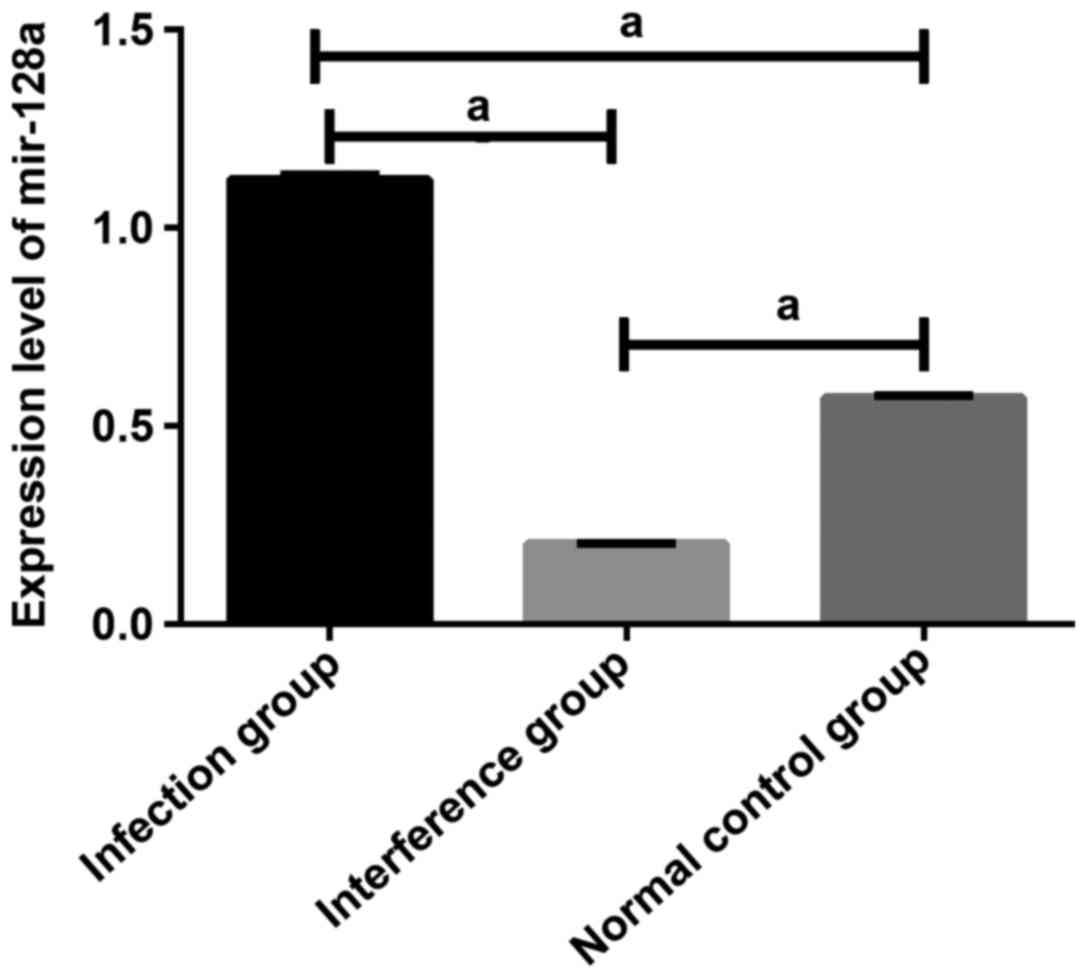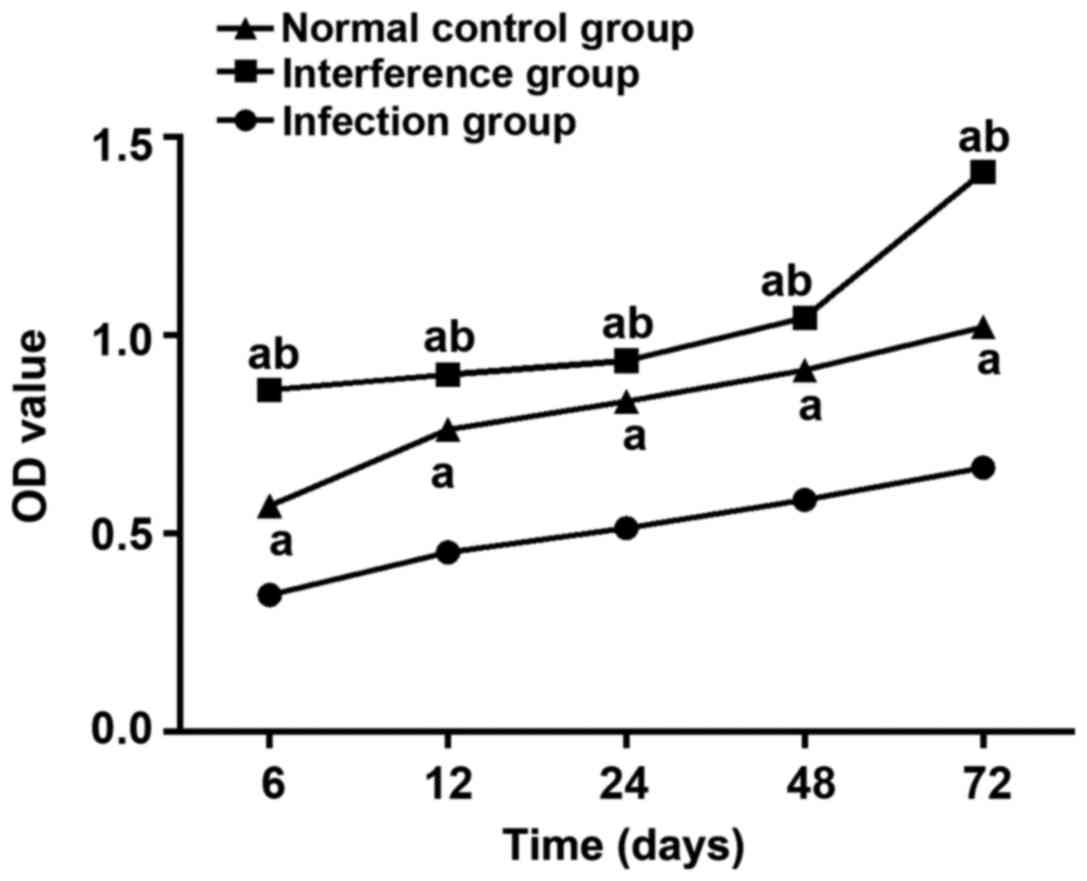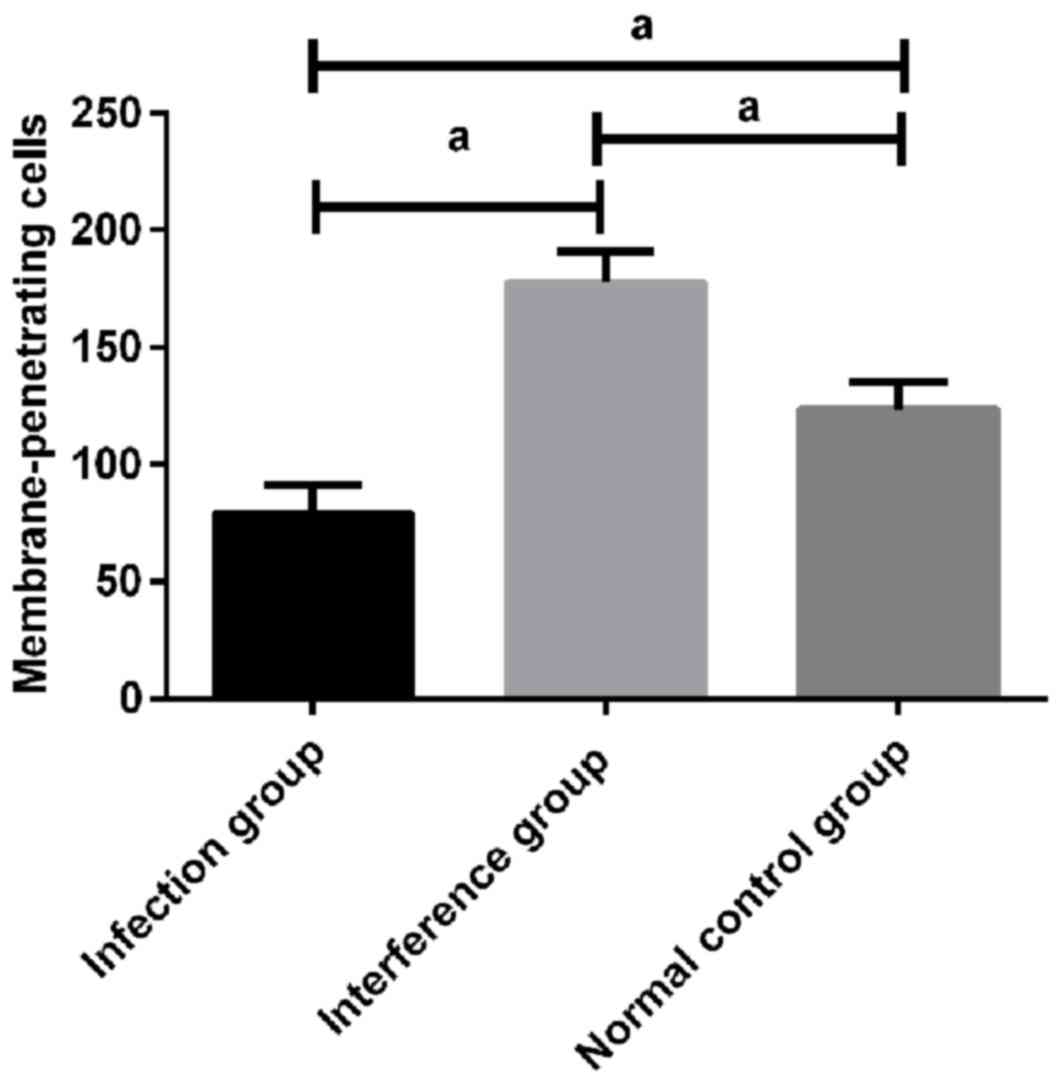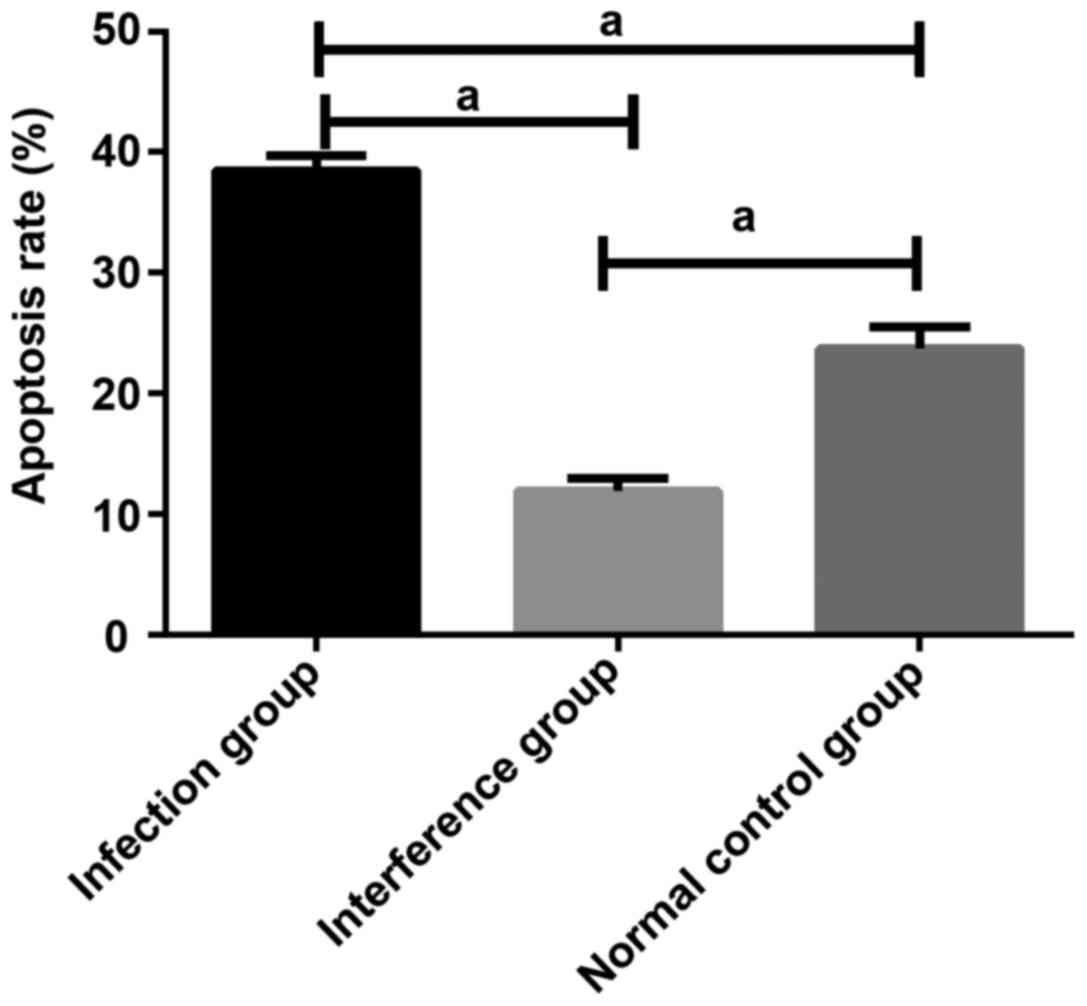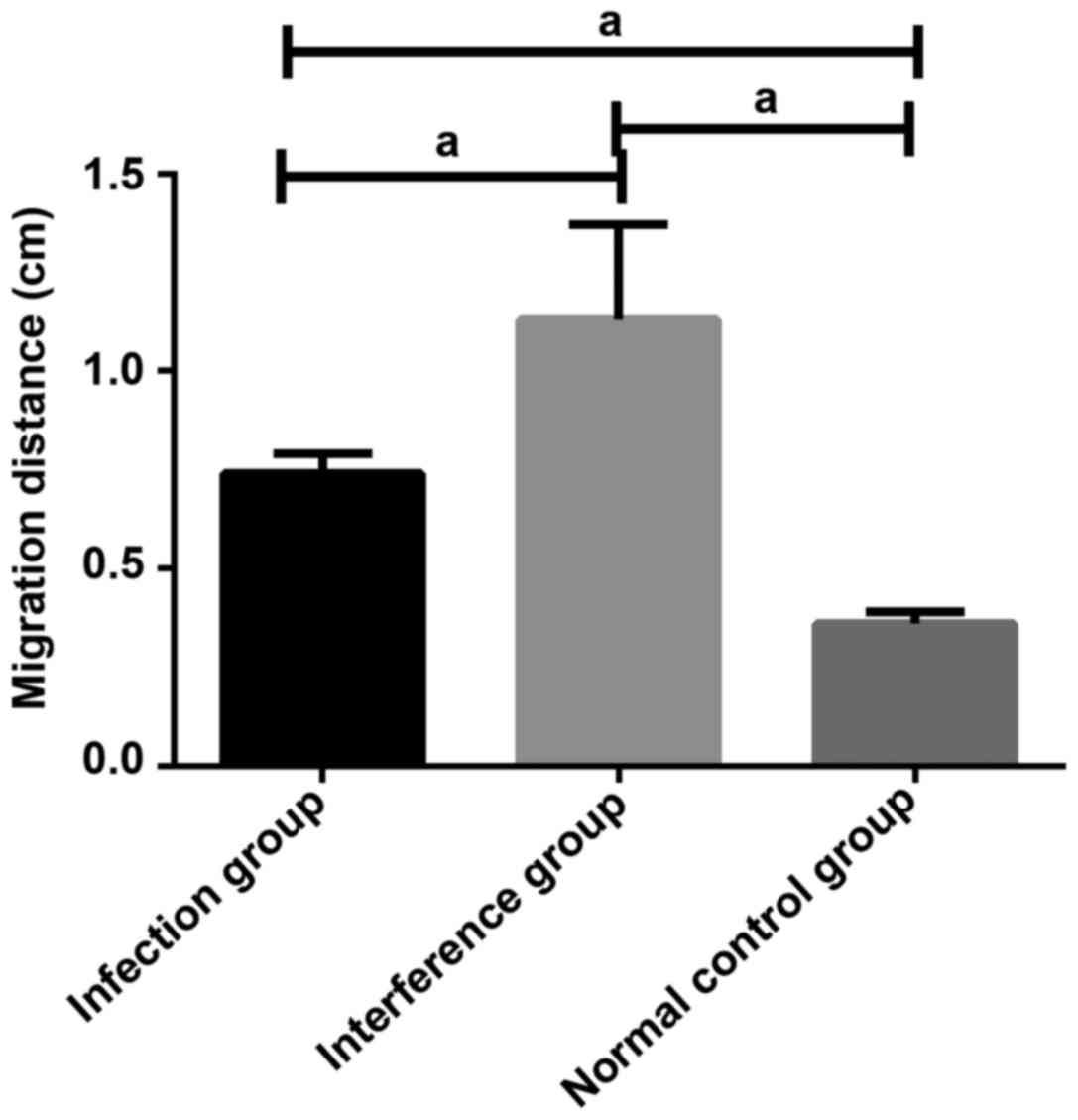Effects of mir-128a on the invasion and proliferation of glioma U251 cells
- Authors:
- Published online on: November 1, 2018 https://doi.org/10.3892/ol.2018.9651
- Pages: 891-896
-
Copyright: © Hu et al. This is an open access article distributed under the terms of Creative Commons Attribution License.
Abstract
Introduction
Glioma is the most common primary malignant tumor of the intracranial tumors, accounting for approximately 45% of all intracranial tumors. The prognosis of glioma patients is generally poor, and the higher the malignant degree is, the worse the prognosis of glioma patients is (1,2). It has been reported (3) that the median survival time of patients with grade IV polyglioblastoma is only one year with less than 5% of 5-year survival rate, which is one of the malignant tumors with the highest human mortality. The treatment of glioma is mainly surgery, supplemented by radiotherapy and chemotherapy (4). Despite the continuous development of medical technology in recent years, the improvement of survival rate of glioma patients is still limited. Many studies have reported that the high mortality rate of glioma is closely related to the excessive proliferation and invasion of tumor cells (5,6).
miRNAs is widely expressed in eukaryotic organism, regulating cell proliferation, differentiation and apoptosis, while abnormal changes in miRNAs biosynthesis are involved in many pathophysiological processes (7,8). Many studies have reported that miRNAs are closely related to biological behavior such as proliferation and invasion of tumor cells (9,10). Guo et al (11) reported that the increased expression level of mir-128a in hepatocellular carcinoma (HCC) could promote the proliferation of HCC cells. However, in the study of Yamada et al (12), it was found that mir-128a could increase the anti-apoptosis ability of Jurkat cells in leukemia patients. Therefore, we speculate that mir-128a plays different roles in different tumors, but there are few studies on the relationship between mir-128a and the biological behavior of glioma cells.
The purpose of this study is to analyze the effects of mir-128a on the biological behavior of glioma U251 cells by regulating the expression level of mir-128a to provide experimental and theoretical basis for clinical treatment, to prolong the patient's life span and to improve the patient's quality of life.
Materials and methods
Cell source
Human glioma U251 cells (cat. no. CC-Y1526), purchased from Shanghai Enzyme Research Biotechnology Co., Ltd. (Shanghai, China), were cultured in DMEM (containing 10% fetal bovine serum) culture medium (Beijing North Tongzheng Biotechnology Development Co., Ltd., Beijing, China). The culture conditions of human glioma U251 cells were 37°C and 5% CO2, and the construction and synthesis of mir-128a expression vector and scramble shRNA were constructed by Shanghai GenePharma Biology Co. (Shanghai, China). The constructed mir-128a-shRNA lentivirus vector (infection group) and scramble shRNA (interference group) were cultured together with human glioma U251 cells digested with trypsin in DMEM (containing 10% fetal bovine serum) culture medium, and then transfected after cultured at culture medium with 37°C 5% CO2 for 48 h. The specific steps referred to the kit instructions and other experimental tests were performed after transfection. The Liposome 2000 transfection kit was purchased from Shanghai Bayley Biotechnology Co., Ltd. (Shanghai, China). A group of U251 cells, which was not infected, was used as control group.
The study was approved by the Ethics Committee of China-Japan Union Hospital of Jilin University (Changchun, China).
Extraction of total miRNA from cells
TRIzol was used to extract and collect (Sigma-Aldrich; Merck KGaA, Darmstadt, Germany) the total RNA of human glioma U251 cells according to the instructions. The concentration and purity of extracted RNA were analyzed by Micro ultraviolet spectrophotometer GeneQuant1300/100D [GE Medical System Trade Development (Shanghai) Co., Ltd., Shanghai, China], and the RNA specimens of A260/A280 between 1.8 and 2.0 were considered to meet the test standard. The integrity of RNA was analyzed by 3% agarose gel electrophoresis (gel electrophoresis set was purchased from Shanghai Jingke Chemical Technology Co., Ltd., Shanghai, China).
Reaction of mir-128a to RT-qPCR
The total RNA extracted above was synthesized of cDNA by reverse transcription according to the instructions in the TaqMan MicroRNA reverse transcription kit [Symevier Technology (China) Co., Ltd., Shenzhen, China]. The cDNA amplification reaction system was 10 µl, 1.0 µl for oligo DT primer, 1.0 µl for dNTP mixture, 2 µg for total RNA, 1 µl for Taq DNA polymerase, and non-ribonuclease distilled water added to 10 µl. Reverse transcription reaction: 37°C for 45 min and 65°C for 5 min. The reaction system was 50 µl, 2 µl for cDNA template, 32.5 µl for SYBR-Green Mix (Guangzhou Dongsheng Biotechnology Co., Ltd.), 0.5 µl for upstream primer and 0.5 µl for downstream primer, and double distilled water added to 50 µl. PCR amplification: 3 min after pre-denaturation at 95°C, 30 sec for denaturation at 95°C, 30 sec for annealing at 55°C, 60 sec for extension at 72°C, 30 cycles, and 5 min for extension at 72°C after the completion of cycle. GAPDH was used as the internal parameter of the reaction. All the samples were repeated three times and the result was analyzed by 2−ΔΔCq (13) method. Primer sequences are shown in Table I.
Proliferation in vitro of human glioma U251 cells detected by MTT assay
The human glioma U251 cells were prepared into single cell suspension and 96-well cell culture plate was used for cell routine inoculation culture. Some of the cultured cells were taken out at 6 h, and 20 µl MTT (5 mg/ml) were added. The supernatant containing impurity was sucked out at 37°C for 4 h, then the dimethylsulfoxide was added and placed on a horizontal shaking bed for 15 min. Finally, the absorbance at 570 nm wavelength was determined by enzyme linked immunosorbent assay (ELISA). The above steps were repeated in the experiment at 12, 24, 48 and 72 h, respectively. MTT test kit was purchased from Shanghai Lianmai Bioengineering Co., Ltd., Shanghai, China.
Transwell invasion in vitro
The prepared U251 cell suspension was inoculated into the Transwell chamber and the number of cells passed through was detected after two weeks. Three parallel trials were conducted simultaneously. The Transwell chamber was purchased from Shanghai Yuanzi Biotechnology Co., Ltd., Shanghai, China.
TUNEL cell apoptosis assay
U251 cells were cultured for 48 h, approximately 5×107/ml, were fixed at room temperature with 4% neutral formaldehyde for 10 min and the excess liquid was removed and washed twice with PBS for 5 min each time. PBSs containing 2% hydrogen peroxide were treated at room temperature for 5 min and the excess liquid was removed and washed twice with PBS for 5 min each time. l TUNEL assay solution (50 μl) was added to each well (the ratio of TdT enzyme to fluorescent labeling solution was 1:24), and incubated at 37°C for 60 min. The cells were dyed according to the instructions provided by TUNEL kit (Shanghai Rong Wei Da Industrial Co., Ltd., Shanghai, China). The cell was sealed with antifade mounting medium and stored at 2–8°C. The number of TUNEL positive cells in 5 fields of vision under the 400-fold microscope was counted by image analysis software (Image-Pro Plus 5.0), and the cumulative optical density value was used to indicate the total number of TUNEL-positive cells. The asssay was repeat three times.
Cell migration ability detected by wound scratch assay
The cells transfected with each group for 48 h were inoculated to a six-well plate, and three groups of repeat wells were set up. When the cell fusion reached approximately 90%, 20 µl was used perpendicular to the 6-well culture plate and drawn according to the pre-prepared horizontal line. PBS was used to wash the plate three times, and 1% FBS DMEM medium was used for continuous cultivation. This was repeated three times with imaging measurement. Cell imaging system Phase-contrast microscope (EVOS® FL Cell Imaging System), Thermo Fisher Scientific, Inc., Waltham, MA, USA.
Statistical analysis
Using SPSS 19.0 (SPSS, Inc., Chicago, IL, USA). The comparison of ratio was tested with χ2. The measurement data were expressed as mean ± standard deviation, the comparison of groups was analyzed by ANOVA and the differences between two groups were detected and analyzed by LSD. The differences were statistically significant (P<0.05).
Results
Analysis of mir-128a detection in U251 cells by RT-qPCR
The result of mir-128a detection in U251 cells by RT-qPCR showed that the expression level of mir-128a in U251 cells of infection group was 1.123±0.012, which was significantly higher than that in U251 cells of interference group, 0.203±0.001 (P<0.05). The expression level of mir-128a in U251 cells of control group was 0.573±0.004, which was significantly lower than that in U251 cells of infection group (P<0.05), but higher than that in U251 cells of interference group (P<0.05) (Fig. 1).
Cell proliferation of U251 cells detected by MTT assay
The result of proliferation in vitro of U251 cells detected by MTT assay showed that the OD values of infection group and control group were lower than that of interference group at 6, 12, 24, 48 and 72 h, and the OD values of infection group were lower than that of control group at 6, 12, 24, 48 and 72 h. The cell proliferation ability of infection group and control group was lower than that of interference group and the cell proliferation ability of U251 cells of infection group was lower than that of U251 cells of control group. The differences were statistically significant (P<0.05) (Fig. 2).
Invasion of U251 cells detected by Transwell migration in vitro
The result of invasion of U251 cells detected by Transwell migration in vitro showed that compared with infection group (79.13±12.04), the number of membrane-penetrating cells (177.58±13.49) in U251 cells of interference group increased significantly (P<0.05). The number of membrane-penetrating cells in U251 cells of control group was 123.72±11.45, which was higher than that of infection group (P<0.05), but lower than that of interference group (P<0.05) (Fig. 3).
Apoptosis of U251 cells detected by TUNEL cell apoptosis assay
The result of apoptosis of U251 cells detected by TUNEL cell apoptosis assay showed that the apoptosis rate of infection and control group (38.47±1.26%, 28.32±1.23%) was significantly higher than that of interference group (11.88±1.11%). The apoptosis rate of infection group was significantly higher than that of control group, and the differences were statistically significant (P<0.05) (Fig. 4).
Migration ability of U251 cells in cell wound scratch assay
Through observing the width of the wound scratch under an inverted optical microscope, it could be found that the migration distance of U251 cells of infection group and interference group was significantly larger than that of U251 cells of control group, and the difference was statistically significant (P<0.05). The migration distance of U251 cells of interference group was significantly larger than that of U251 cells of infection group, and the difference was statistically significant (P<0.05) (Fig. 5).
Discussion
The occurrence and development of tumor is a pathological process where multi-step and multi-molecular are involved, and its most important biological features are the ability of almost infinite proliferation and extremely high ability of invasion and metastasis of malignant tumor cells (14,15). The main reason for the high recurrence rate and low survival rate of glioma patients is the invasiveness and metastasis of glioma cells (16,17). Therefore, it is of great significance to explore the related molecular mechanism of glioma cell proliferation and invasion, to provide experimental and theoretical reference for inhibiting the excessive proliferation and invasion of glioma cells, to increase the survival rate of patients and to improve their quality of life.
In this study, mir-128a-shRNA lentivirus vector was constructed to upregulate the expression level of mir-128a in human glioma cell U251, and scramble shRNA was constructed to interfere with the expression of mir-128a in human glioma cell U251. The result of comparison with the expression level of mir-128a in uninfected U251 cells showed that the expression level of mir-128a in U251 cells of infection group was significantly higher than that in U251 cells of interference group, and the expression level of mir-128a in U251 cells of control group was significantly lower than that in U251 cells of infection group, but higher than that in U251 cells of interference group. The expression vector was successfully transfected into glioma U251 cells and expressed successfully, which was consistent with the previous expectation. In this study, the result of biological behavior detection of glioma U251 cells showed that upregulation the expression level of mir-128a could inhibit the ability of proliferation, invasion and migration of glioma U251 cells, and promote apoptosis level of glioma U251 cells. Therefore, we conclude that mir-128a could inhibit the malignant biological behavior of glioma cells.
Nie et al (18) reported that upregulation of mir-128a could inhibit the proliferation ability of glioma U87 cells. Venkataraman et al (19) found that mir-128a target regulated Bmi-1, increased the level of intracellular reactive oxygen species, and promoted the senescence of neural tubular tumor cells, thereby inhibiting tumor proliferation. From these results we can infer that mir-128a may play a role as anti-oncogene in central nervous system tumors, but the mechanism of action of mir-128a in glioma cells needs to be further verified. The Bmi-1 and reactive oxygen species level is a very good direction and Bmi-1 gene is one of the core members of the PcG family. Bmi-1 is highly expressed in tumor cells, which makes tumor cells regenerate into cancer stem cells (19). Nevertheless, De Luca et al (20) reported that lowering the level of mir-128a could induce the increase of Lin28a expression and LIN28 could regulate the self-renewal of stem cells and improve bone marrow differentiation disorder in patients with acute myeloid leukemia. Guo et al (11) found that miR-128a was upregulated in hepatocellular carcinoma and promoted the proliferation of hepatocellular carcinoma cells by targeting RND3 and RND3 was a member of the Rnd subgroup of the Rho family of GTP enzymes and regulated the tissue of actin cytoskeleton through the response of extracellular growth factors. From their results we can find that miR-128a plays a role similar to oncogene in hepatocellular carcinoma and acute myeloid leukemia. Therefore, we speculate that miR-128a may inhibit the biological behavior of tumors in the central nervous system, such as glioma, thus promoting the biological behavior of hepatocellular carcinoma, leukemia and other organic cancers as well as blood cancer.
Ye et al (21) found that U-87MG glioblastoma cells exposed to X-ray radiation could decrease the expression level of mir-128a, induce the upregulation of the expression level of Bmi-1, and then lead to the decrease of reactive oxygen species in cells, which would cause the cells to escape from aging and death. This may also be one of the reasons why the radiotherapy effects of glioma patients is not satisfactory, and we will further verify the effects of mir-128a on the radiotherapy effects of glioma cells in the future studies. This study also investigated cell lines, so more clinical studies are needed to prove the results of this study.
Collectively, mir-128a may play a role similar to anti-oncogene in glioma, inhibiting the ability of proliferation, invasion and migration of glioma cells, and promoting apoptosis of glioma cells.
Acknowledgements
Not applicable.
Funding
No funding was received.
Availability of data and materials
The datasets used and/or analyzed during the present study are available from the corresponding author on reasonable request.
Authors' contributions
GH drafted the manuscript. GH and WF were mainly devoted to extraction of total miRNA from cells. GH and NL were responsible for transwell invasion in vitro. CL performed RT-qPCR. All authors read and approved the final manuscript.
Ethics approval and consent to participate
The study was approved by the Ethics Committee of China-Japan Union Hospital of Jilin University (Changchun, China).
Patient consent for publication
Not applicable.
Competing interests
The authors declare that they have no competing interests.
References
|
Eckel-Passow JE, Lachance DH, Molinaro AM, Walsh KM, Decker PA, Sicotte H, Pekmezci M, Rice T, Kosel ML, Smirnov IV, et al: Glioma groups based on 1p/19q, IDH, and TERT promoter mutations in tumors. N Engl J Med. 372:2499–2508. 2015. View Article : Google Scholar : PubMed/NCBI | |
|
Vogelstein B, Kinzler KW, Parsons DW, Zhang X, Lin CH, Leary RJ, Angenendt P, Papadopoulos N, Velculescu V, Parmigiani G, et al: Genetic alterations in isocitrate dehydrogenase and other genes in malignant glioma. US Patent 2017/0081730 A1. Filed November 16, 2016; issued. March 23–2017. | |
|
Ceccarelli M, Barthel FP, Malta TM, Sabedot TS, Salama SR, Murray BA, Morozova O, Newton Y, Radenbaugh A, Pagnotta SM, et al; TCGA Research network, . Molecular profiling reveals biologically discrete subsets and pathways of progression in diffuse glioma. Cell. 164:550–563. 2016. View Article : Google Scholar : PubMed/NCBI | |
|
Noch EK, Ramakrishana R and Magge R: Challenges in the treatment of glioblastoma: Multisystem mechanisms of therapeutic resistance. World Neurosurg. 116:505–517. 2018. View Article : Google Scholar : PubMed/NCBI | |
|
Johnson BE, Mazor T, Hong C, Barnes M, Aihara K, McLean CY, Fouse SD, Yamamoto S, Ueda H, Tatsuno K, et al: Mutational analysis reveals the origin and therapy-driven evolution of recurrent glioma. Science. 343:189–193. 2014. View Article : Google Scholar : PubMed/NCBI | |
|
Venugopal C, McFarlane NM, Nolte S, Manoranjan B and Singh SK: Processing of primary brain tumor tissue for stem cell assays and flow sorting. J Vis Exp. 67(pii): 41112012. | |
|
Leidinger P, Backes C, Meder B, Meese E and Keller A: The human miRNA repertoire of different blood compounds. BMC Genomics. 15:4742014. View Article : Google Scholar : PubMed/NCBI | |
|
Brabants E, Pyfferoen L, Everaert C, Tavernier SJ, Heyns K, De Cabooter N, Wagemans G, Deswarte K, Hammad H, de wever O, et al: Specific myelomonocytic cells heavily infiltrate orthotopic lung tumors and display a hypoxia-driven miRNA expression signature that directs tumor-supporting functions and negatively impacts on clinical outcome. Cancer Immunol Res. 4 Suppl 11:Abst A091. 2016. View Article : Google Scholar | |
|
Rupaimoole R, Calin GA, Lopez-Berestein G and Sood AK: miRNA deregulation in cancer cells and the tumor microenvironment. Cancer Discov. 6:235–246. 2016. View Article : Google Scholar : PubMed/NCBI | |
|
Bleckmann A, Leha A, Artmann S, Menck K, Salinas-Riester G, Binder C, Pukrop T, Beissbarth T and Klemm F: Integrated miRNA and mRNA profiling of tumor-educated macrophages identifies prognostic subgroups in estrogen receptor-positive breast cancer. Mol Oncol. 9:155–166. 2015. View Article : Google Scholar : PubMed/NCBI | |
|
Guo X, Cao C, Sun J, Zhang D, Liu L and Wu D: miR-128a is up-regulated in hepatocellular carcinoma and promotes tumor cell proliferation by targeting RND3. Nan Fang Yi Ke Da Xue Xue Bao. 34:1408–1413. 2014.(In Chinese). PubMed/NCBI | |
|
Yamada N, Noguchi S, Kumazaki M, Shinohara H, Miki K, Naoe T and Akao Y: Epigenetic regulation of microRNA-128a expression contributes to the apoptosis-resistance of human T-cell leukaemia jurkat cells by modulating expression of fas-associated protein with death domain (FADD). Biochim Biophys Acta. 1843:590–602. 2014. View Article : Google Scholar : PubMed/NCBI | |
|
Livak KJ and Schmittgen TD: Analysis of relative gene expression data using real-time quantitative PCR and the 2(-Delta Delta C(T)) method. Methods. 25:402–408. 2001. View Article : Google Scholar : PubMed/NCBI | |
|
Topalian SL, Sznol M, McDermott DF, Kluger HM, Carvajal RD, Sharfman WH, Brahmer JR, Lawrence DP, Atkins MB, Powderly JD, et al: Survival, durable tumor remission, and long-term safety in patients with advanced melanoma receiving nivolumab. J Clin Oncol. 32:1020–1030. 2014. View Article : Google Scholar : PubMed/NCBI | |
|
Bettegowda C, Sausen M, Leary RJ, Kinde I, Wang Y, Agrawal N, Bartlett BR, Wang H, Luber B, Alani RM, et al: Detection of circulating tumor DNA in early- and late-stage human malignancies. Sci Transl Med. 6:224ra242014. View Article : Google Scholar : PubMed/NCBI | |
|
Buckner JC, Shaw EG, Pugh SL, Chakravarti A, Gilbert MR, Barger GR, Coons S, Ricci P, Bullard D, Brown PD, et al: Radiation plus procarbazine, CCNU, and vincristine in low-grade glioma. N Engl J Med. 374:1344–1355. 2016. View Article : Google Scholar : PubMed/NCBI | |
|
Mellinghoff IK, Touat M, Maher E, DeLaFuente M, Cloughesy TF, Holdhoff M, Cote G, Burris H, Janku F, Huang R, et al; ACTR-46. AG120, a first-in-class mutant IDH1 inhibitor in patients with recurrent or progressive IDH1 mutant glioma, . Results from the phase 1 glioma expansion cohorts. Neuro Oncol. 18 Suppl 6:vi122016. View Article : Google Scholar | |
|
Nie QM, Lin YY, Yang X, Shen L, Guo LM, Que SL, Li XX, Ge JW, Wang GS, Xiong WH, et al: IDH1R¹32H decreases the proliferation of U87 glioma cells through upregulation of microRNA-128a. Mol Med Rep. 12:6695–6701. 2015. View Article : Google Scholar : PubMed/NCBI | |
|
Venkataraman S, Alimova I, Fan R, Harris P, Foreman N and Vibhakar R: MicroRNA 128a increases intracellular ROS level by targeting Bmi-1 and inhibits medulloblastoma cancer cell growth by promoting senescence. PLoS One. 5:e107482010. View Article : Google Scholar : PubMed/NCBI | |
|
De Luca L, Trino S, Laurenzana I, Tagliaferri D, Falco G, Grieco V, Bianchino G, Nozza F, Campia V, D'Alessio F, et al: Knockdown of miR-128a induces Lin28a expression and reverts myeloid differentiation blockage in acute myeloid leukemia. Cell Death Dis. 8:e28492017. View Article : Google Scholar : PubMed/NCBI | |
|
Ye L, Yu G, Wang C, Du B, Sun D, Liu J, Qi T, Yu X, Wei W, Cheng J, et al: MicroRNA-128a, BMI1 polycomb ring finger oncogene, and reactive oxygen species inhibit the growth of U-87 MG glioblastoma cells following exposure to X-ray radiation. Mol Med Rep. 12:6247–6254. 2015. View Article : Google Scholar : PubMed/NCBI |



